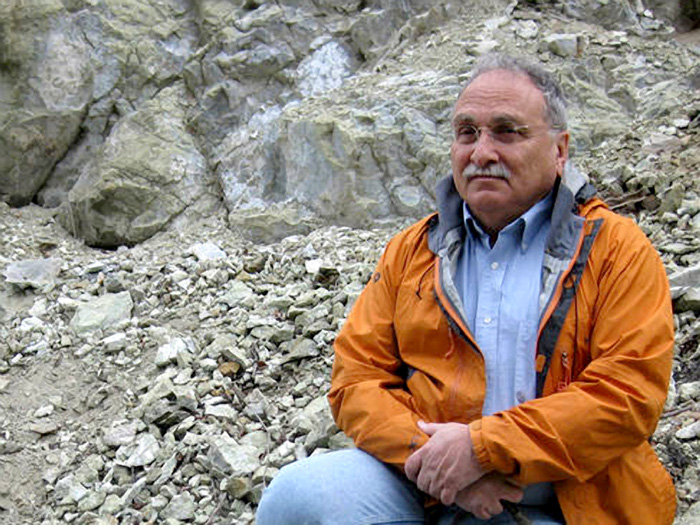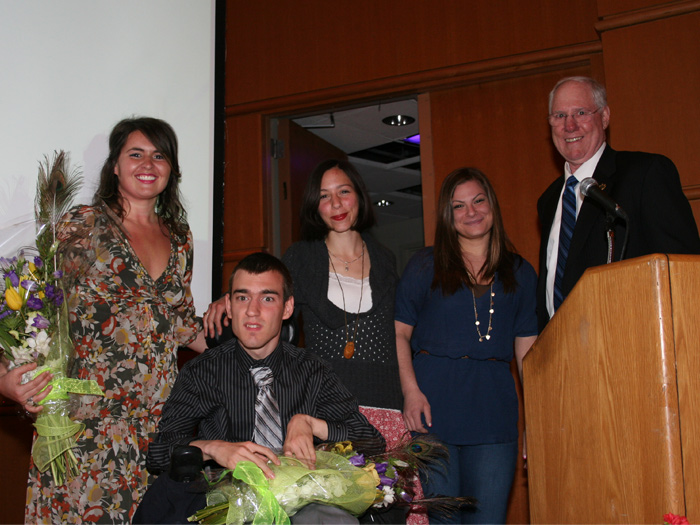[flowplayer src=’https://csitoday.com/wp-content/uploads/video-player/assets/video/csigeologist.mov’ width=320 height=180 splash=’https://csitoday.com/wp-content/uploads/video-player/assets/images/csigeologist.jpg’]Staten Island’s literally “rocky” past–and future–were analyzed this May by veteran CSI geologist Dr. Alan I. Benimoff on the “Cosmic Fury” episode of the prestigious Known Universe TV series on the National Geographic Network.
Participation in the internationally broadcast program along with prominent scientists from Caltech, the University of Arizona, the United States Geological Survey, astronomers and others, symbolized recognition of CSI as “world class” according to Benimoff.
A distinguished scientist in his own right, Dr. Benimoff discovered a new classification of mineral from a talc mine in St. Lawrence County New York in 2004. Specimens are part of the collections of the New York State Museum and the Smithsonian Institute in Washington, DC.
For Known Universe, Dr. Benimoff had taken the TV crew members to two sites–one in Sunnyside, the other in Graniteville–and he emphasized that, by analyzing the rocks found there, it was possible to determine what type of plate boundaries existed there in the past.
Because “the surface of the Earth is a mosaic of rigid shifting plates, known as plate tectonics,” he said, “the rocks are telling us that the Earth we see now may differ in the future and the continental configuration seen now will not be the one of the future.”
The Sunnyside site, near route I-278, has Serpentinite rocks “that signify an ancient convergent plate boundary where an island arc volcanic system crashed into the ancient North American continent some 440 million years ago.”

CSI’s Alan Benimoff sitting on an outcrop of Serpentinite rock near the Staten Island Expressway.
The Graniteville quarry, on Forest Avenue between Van Name and Simonson Avenues, has rocks of an ancient divergent plate boundary. “They formed when the supercontinent of Pangaea broke up some 200 million years ago.
“Until about 22,000 years ago there was no Staten Island, and this area was all over the globe. The ancient North American continent (named Laurentia) was at the equator some 500 million years ago, then drifted north. The drainage of our area was changed about 22,000 years ago when the vast ice sheet covering this area retreated. Its farthest southern advance was where Tottenville is now.”
Aired three times this month (May) the one-hour program was “great” for CSI, he said, because it contributes to the College’s national and international recognition.
No newcomer to TV, Dr. Benimoff has been co-producing and co-hosting about 65 episodes of Geology Forum, a live monthly program on Staten Island Community Television for the last six years. It is broadcast the first Friday of each month at 8:00pm on Time-Warner Channel 35 and Verizon FIOS Channel 35, and repeated two weeks later on Time Warner Channel 57 and FIOS Channel 37 at 10:00pm.
On June 15, Dr. Benimoff will mark his 43rd year on CSI’s full-time instructional staff. He has done extensive research on Staten Island rocks, written numerous scientific papers on the Island’s geology and, in 2004, discovered a new mineral.
A member of CSI’s Department of Engineering Science and Physics he teaches the Environmental Sciences Master’s Program courses: ESC 752 Soils and Geohydrology and ESC 703 Earth Science, as well as Physical geology in the Verrazano School Program and GEO 105 Environmental Geology and GEO 102/103 Historical Geology.
Dr. Benimoff earned a PhD in Geology from Lehigh University, his MA and BS in Geology from Brooklyn College, and his AS in Engineering Science from CSI.
After finishing his AS degree in spring 1967, he was hired as a full-time technical assistant (now called CLT), working in CSI’s Physics Lab. That summer session, he went on a geology field trip and “got hooked on geology.” Instead of continuing his Engineering BS degree, he decided to major in Geology and continued his geological education at night at Brooklyn College.















